Pandemic Family Traditions: What to Change and What to Keep [Survey]

There’s no doubt that the COVID-19 pandemic has drastically impacted the way family members interact with one another. Last year saw many parents learning how to cope with working from home while their kids learned remotely in the next room. Over the past 15 months, many families spent more time together than they were previously used to – and in doing so, many of their habits and activities changed. Families developed new traditions to get themselves through a strange and disorienting time.
However, now that the pandemic is easing its hold on American society, the question becomes: Will these pandemic traditions stick? And which traditions are worth holding onto?
We surveyed 1,006 parents about their family experiences during the pandemic to shed light on these new traditions and how they’ve impacted family dynamics. In doing so, we gained some surprising insights into the way the pandemic has affected families and how parents and children relate to each other.
Highlights
- 93% of parents felt more connected to their kids due to their new pandemic-era traditions.
- Parents reported that family walks, family dinners, and sharing stories and daily experiences were the traditions that most improved family relationships during the pandemic.
- 65% of fathers reported better relationships with their children, compared to 60% of mothers.
- Parents with children aged 4 years old and younger were the most likely to admit they would not miss having extra time with their children, with more than one-fifth reporting as much.
A Changing Family Landscape
The most obvious way the pandemic impacted families over the past year was in the increased time that parents and children spent with each other.
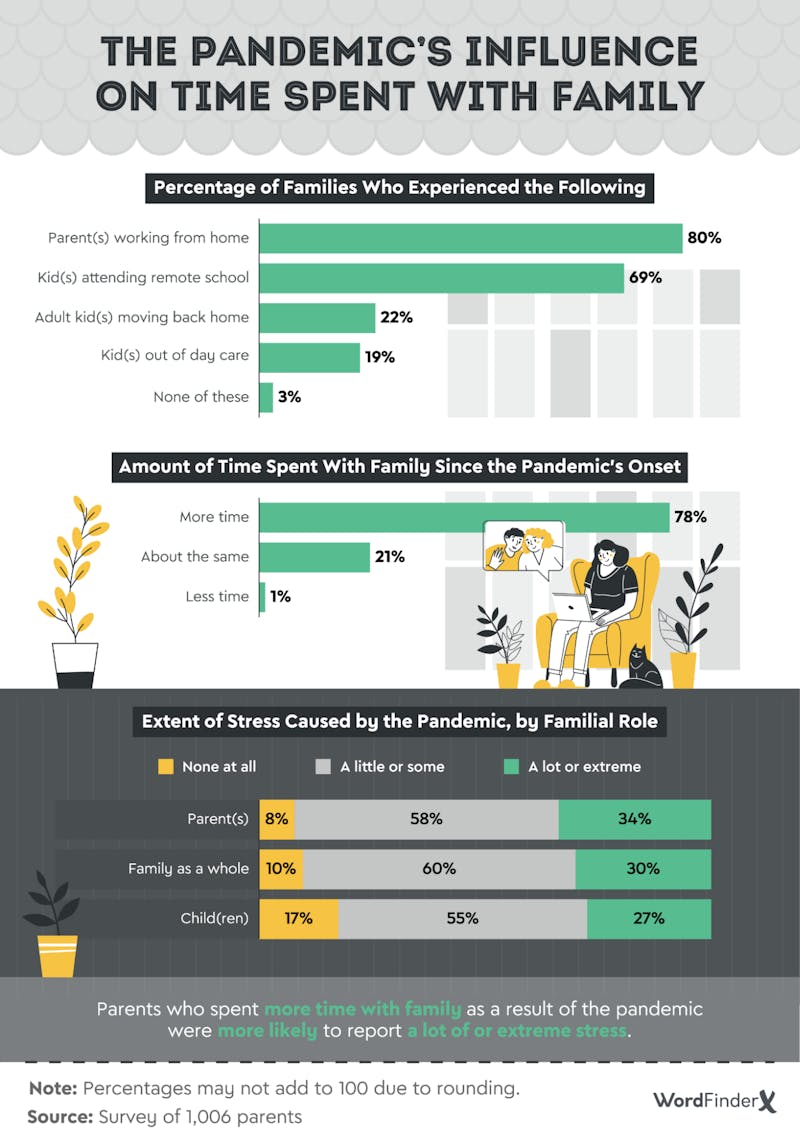
Of the parents we surveyed, 80% reported that they worked from home during the pandemic, while 69% said their kids learned remotely during that time. One in 5 families had an adult child move back home, and a similar number reported that they had kids staying home from day care.
The result? Most families experienced more time together than ever before during the pandemic. Unsurprisingly, parents felt the impact of this shift the most. Fifty-eight percent of parents were somewhat stressed by this increased family interaction, and more than a third felt a lot or extreme stress as a result.
As parents dealt with an unfamiliar family landscape, they found themselves forced to come up with new routines and coping strategies. Thus, new family traditions were born.
Out With the Old, in With the New
With old schedules and habits out the window, parents had to discover new ways of interacting with their children.
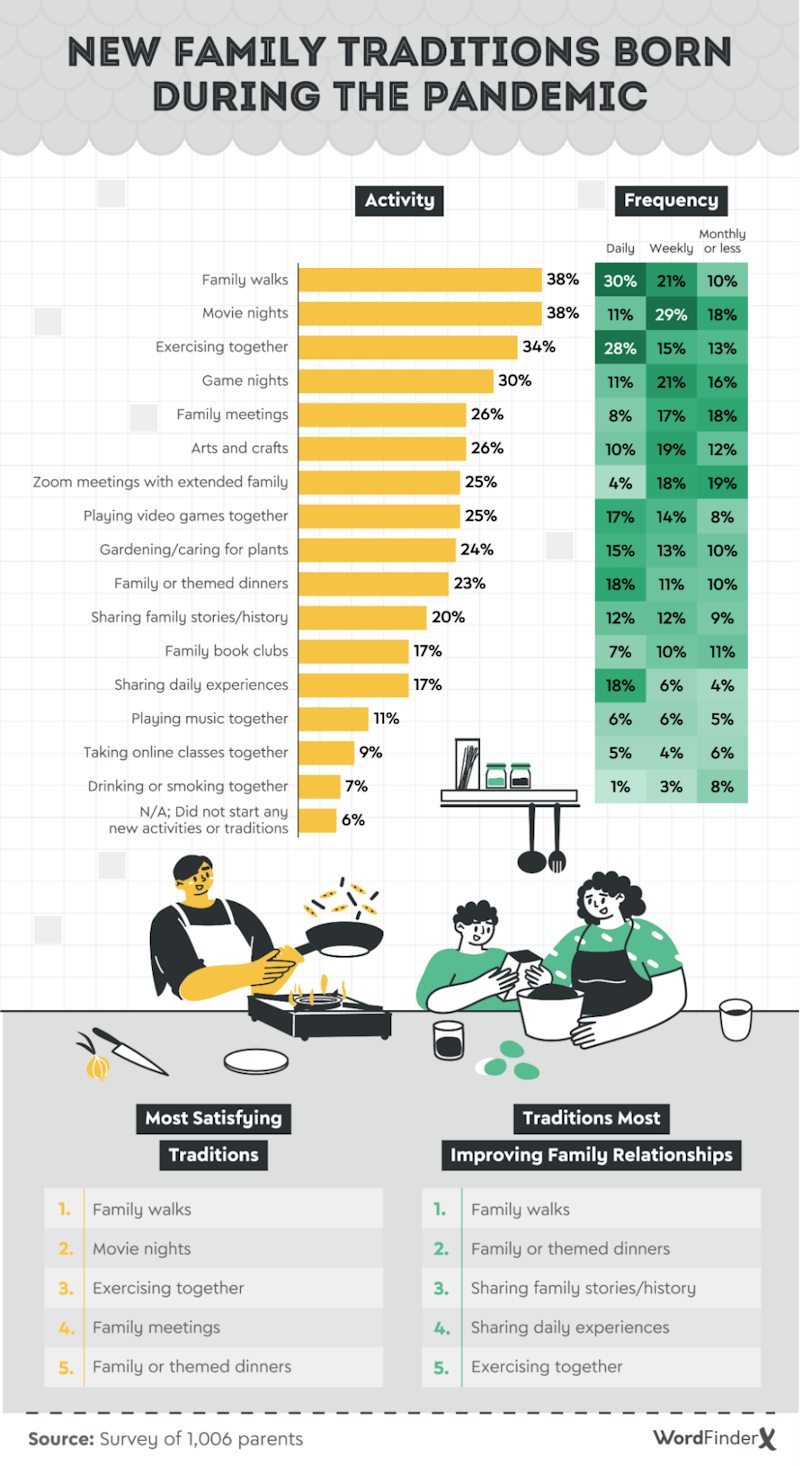
The parents we surveyed reported a slew of new bonding activities, with some of the most popular being family walks, movie nights, group exercise, and game nights. The traditions that families leaned on the most often in their day-to-day life were family walks, followed by group exercise, and then a tie between family or themed dinners and sharing daily experiences. Other popular activities included arts and crafts, Zoom meetings with extended family and playing video games together.
We were curious as to which of these new activities most improved family relationships. The parents we surveyed reported that family walks, family dinners, and sharing stories and daily experiences led to the most bonding. That finding makes sense given that two of the foundations of a strong parent-child relationship include eating meals together and listening/empathy.
We also asked parents about which new traditions they found the most satisfying. Here – again – family walks topped the list, but movie nights and exercising together were also strong contenders, as were family meetings and family dinners. Perhaps these activities were so powerful because they represented shared experiences, which studies have shown increase our feelings of closeness with others.
Feeling the Impact
Given that family traditions changed so drastically and abruptly in 2020, it makes sense that families felt the impact on many different levels. We asked parents how these new activities affected family dynamics and which added to or alleviated stress.
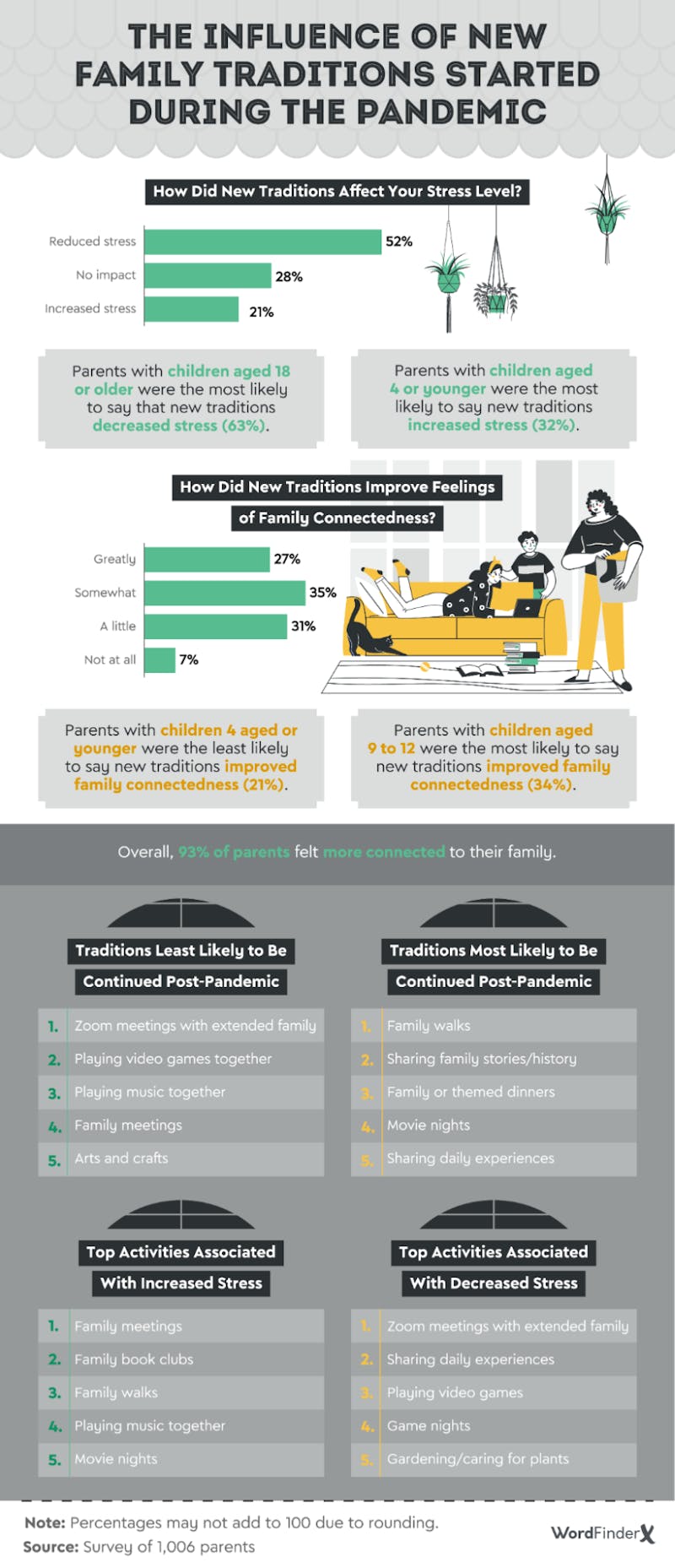
For the most part, these new activities seemed to reduce stress, with over half of parents reporting lower family stress levels after taking them up.
However, stress levels varied among parents. Parents with younger children (aged 4 and under) were more likely to say that these new family traditions increased stress. This is perhaps unsurprising, considering that parents of young children often struggle to keep their kids entertained or engaged while they themselves are trying to work from home. In contrast, parents with older, more independent children (aged 18 and up) found that the new traditions tended to ease tensions within the family.
Overall, most families found that their new traditions increased feelings of connectedness, with over 90% of parents reporting feeling more bonded with other family members. However, which of these traditions will persist now that families are emerging from their relative isolation?
The parents we surveyed said they would most likely continue with family walks, sharing stories and experiences with each other, and family dinners. The activities they anticipated phasing out included family Zoom meetings and video games – probably because a post-pandemic life will involve far less screen time and more in-person interactions.
When reflecting on which activities alleviated family stress, parents pointed to Zoom meetings and sharing daily experiences (activities that increased quality time and thoughtful communication) as well as video games, game nights, and gardening or plant care (shared experiences).
Interestingly, some of the traditions that parents said they intended to continue were associated with more stress as opposed to less. Family walks and movie nights were both reported as top activities to continue after the pandemic, despite being rated as more stress-inducing than other pastimes. Perhaps the benefits of these activities outweighed the downsides. Family meetings, book clubs, and playing music together were also more likely to be associated with an increase in stress.
Examining the Change
With all this change taking place in family households, we were curious: How did these new traditions affect parent-child relationships?
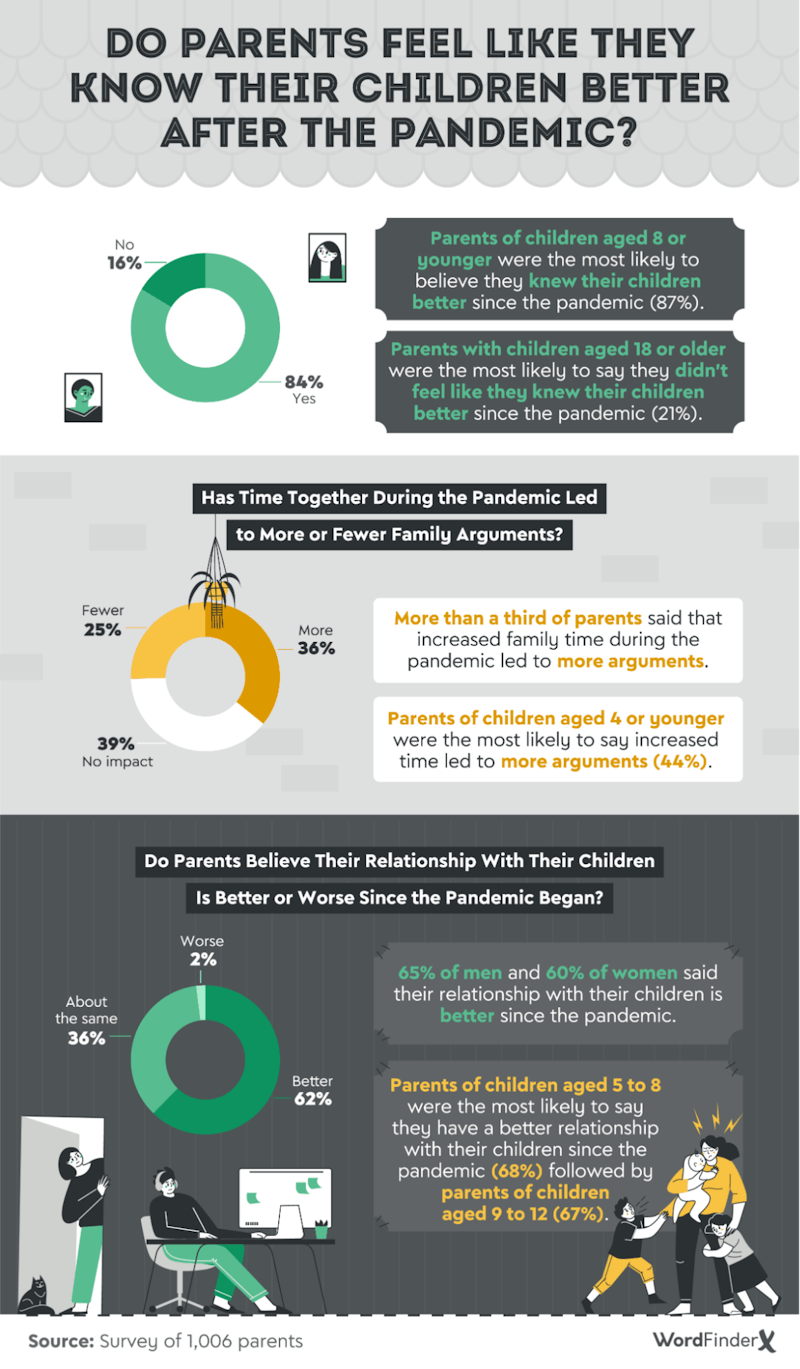
The biggest change seemed to be that parents got to know their children better. A whopping 84% of parents reported that they felt they knew their children better after weathering the pandemic together.
However, the increased family closeness wasn’t always easy. More than a third of parents reported that more family interaction during the pandemic led to more arguments. This sentiment was especially strong among parents who had young children, perhaps because they were experiencing significant stressors due to economic instability and a lack of child care options.
Overall, however, the majority of parents reported that their relationships with their children had strengthened. Interestingly, 65% of men reported better relationships with their children (compared to 60% of women), which perhaps reflects the increased participation of men in family roles during the pandemic.
Looking Ahead to a New Normal
As the pandemic begins to relent, we asked parents to look ahead and speculate what their family dynamics might look like in the future.
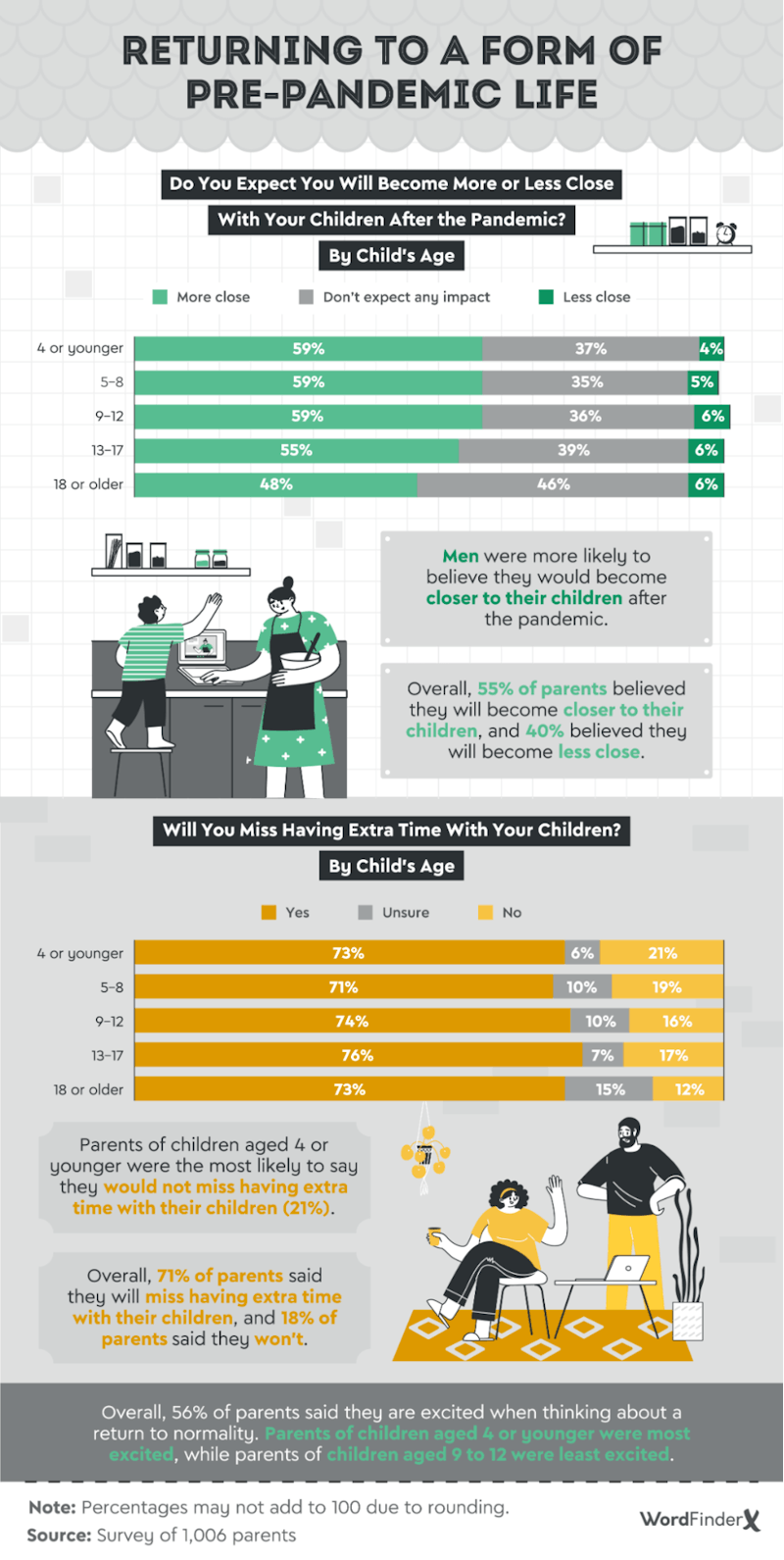
The majority of the parents we surveyed said they expected to become closer – or at least maintain their current level of closeness – with their children. When contemplating a return to a more normal lifestyle, many respondents expressed slight regret; 71% of parents said they would miss the increased time with their kids.
However, parents of children aged 4 and under were more ready for a break from intensive family time; more than a fifth of these parents said they wouldn’t miss the extra time with their kids. As mentioned before, given the mental and emotional burdens placed on parents of young children during the pandemic, it’s understandable that they’re looking forward to a slight respite.
And they’re not alone in their excitement about a return to a more normal lifestyle. Over half of the parents we surveyed were excited to emerge from the pandemic’s year of isolation, although parents of children aged 9 to 12 years old were the least likely to express this sentiment.
Lessons to Learn
The pandemic has transformed almost all aspects of American life, but its impact has been felt perhaps the most strongly within the family unit. As parents and children sheltered in place, they experienced both the positive and negative aspects of more time together. Stress levels were elevated, but family members also fostered closer, more positive relationships. As the pandemic ends, it’s intriguing to consider what important lessons we can take from quarantine back into our normal everyday life by continuing – or discontinuing – the traditions formed amid the pandemic.
Building on Family Bonds
Are you looking for a way to build and maintain positive family interactions as we move out of pandemic mode? One of the best ways for families to bond is through quality time and shared experiences. Board games and word puzzles can provide fun for the whole family, and a game of Scrabble or a group effort to complete a crossword can be bonding and satisfying. If you find yourself in need of assistance while settling into game night with the family, head over to Word Finder, where you can unscramble new words, learn new definitions, and settle any debates about accuracy.
Methodology and Limitations
We surveyed 1,006 parents about family life during and after the pandemic where respondents were presented with a series of questions, including attention-check and disqualification questions. Respondents were 48.7% women and 51.1% men. Two respondents were nonbinary. The average age of respondents was 38.5.
Data on household experiences as a result of the pandemic; new activities or traditions families started during the pandemic; and activities or traditions parents believed led to stronger relationships among their family were gathered using check-all-that-apply questions. Therefore, percentages won’t add to 100.
The data we are presenting rely on self-report. There are many issues with self-reported data. These issues include, but are not limited to, the following: selective memory, telescoping, attribution, and exaggeration.
Fair Use Statement
Did your family start any of the new pandemic-era traditions listed here? Feel free to use and share this article for all noncommercial purposes, but please remember to link back to our study to give credit to our contributors. Thank you.